Evaluating Urban Green Public Spaces: The Case Study of Krasnodar Region Cities, Russia
Abstract
:1. Introduction
2. Materials and Methods
2.1. Study Area
- The first group: Sochi (176.77 square kilometers; 432,322 inhabitants) and Tuapse (33.41 sq km.; 60,987 inhabitants), situated along the Black Sea coast, both with humid subtropical climates;
- The second group: Yeysk (144 square kilometers; 83,127 inhabitants) and Temryuk (20.1 sq km.; 41,281 inhabitants), situated on the shore of the Sea of Azov, both with humid continental climates;
- The third group: Armavir (280 square kilometers; 187,215 inhabitants) and Abinsk (22 square kilometers; 39,186 inhabitants), located at Kuban-Azov lowland, with moderately continental climate features.
2.2. Methodological Approach for the Development of Urban GreenPS Network
- Data collecting;
- Defining the urban GreenPS network structure;
- Project suggestions to the city master plan.
- The basic settlement parameters;
- The GreenPS parameters.
- DN—GreenPS density coefficient;
- SGreenPS—the area occupied by GreenPS elements, square kilometers;
- Sres—residential area of the city, square kilometers.
- —sufficiency index, square kilometers/inhabitant;
- SGreenPS—total area of the city GreenPS, square kilometers;
- N—the number of city inhabitants.
- —the continuity of GreenPS, percentage;
- Scont.—the continuous parcel of the total GreenPS area, square kilometers;
- Stotal—the total GreenPS area, square kilometers.
- greening (lawns, plants, flower beds);
- physical activities (walking, jogging, running and cycling, fitness, sport games, cardio training);
- leisure and recreation activities (benches, picnic areas, fountains, spaces for dancing, reading, meditating, probable access to water bodies);
- play (play areas for children and adults);
- education and commercial attraction (objects of monumental or architectural heritage, archeological sites, religious services, catering, touristic tours);
- mobility services (cycling and pedestrian paths, bus stops, parking places).
- endemic areas of historical value;
- protected areas with rich biodiversity;
- unique bird or animal reserves.
- air quality;
- sufficient toilet and hand washing and sanitizing facilities;
- closed sewage systems and garbage collection;
- available clean drinking water;
- sewage disposal;
- proper cleaning and sanitation of outdoor equipment and facilities;
- safe use and handling of pesticides and other harmful chemicals;
- avoid potentially dangerous pieces of flora and fauna;
- protection facilities from bad weather (rain, snow, sun heat, etc.);
- engineered protection facilities from extreme natural phenomena (landslides, floods, tsunamis, etc.)
- since the year 2020, possibility to provide a sanitary safety distance of 1.5 m.
- Renewed for creating new GreenPS;
- Reconstructed by integrating functional diversity;
- Revitalized by building attractive green and cultural environment;
- Modernized by using green, energy-efficient and technologically advanced equipment.
- New areas incorporating sustainable GreenPS land use, such as street sections, embankments, seafronts or pedestrian bridges and walkways, footpaths to be used as connecting corridors aimed at providing the Continuity, Accessibility, Density and Sufficiency of the GreenPS spaces network;
- Renovating already present GreenPS by multiplication of social, business and environmental functions to increase Value and Diversity indices;
- Investing in green facilities addressing improving the Cleanand Sanitary index, such as public toilets, efficient drainage, clean water supply and clean air monitoring.
3. Results
3.1. The Data Collection Results
3.1.1. Sochi
- Accessibility: Sochi is located on the slopes of the Great Caucasian chain. Foothills and large local differences in elevation explain the poor accessibility of green areas: straight-line access to green facilities alternates with prolonged climbs or descents. The access time can be more than 30 min. The average is 15-min access.
- Density: The Density coefficient of the city-wide green belt is equal to 0.087.
- Sufficiency: The sufficiency indicator of the GreenPS constitutes 9 square meters/inhabitant.
- Continuity: GreenPS are linked mostly by linear corridors, such as the embankments and paths along the rivers descending from the mountains to the sea, and provide for 65% of the GreenPS Continuity.
- Diversity: The Diversity coefficient is high and can be evaluated equal to 100%: All Central Sochi parks are multifunctional and provide a variety of ecological sites for special events, festivals, sports tournaments and educational and recreational activities, which are the major sources of tourism and social and economic benefits.
- Value: 100%: the warm Mediterranean climate creates unique conditions for rich biodiversity of local flora and fauna.
3.1.2. Tuapse
- Accessibility: The city’s terrain is rugged. The absolute altitudes range from 0 m above sea level to 422 m above sea level (Mount Bezymyannaya). However, due to the existing GreenPS backbone, the average accessibility is 20-min access.
- Density: The Density coefficient is equal to 0.52, but almost 40% of GreenPS is not landscaped and it is rarely used.
- Sufficiency: The total area of public green areas in Tuapse is 105 hectares, and the supply of green space is 50 square kilometers/inhabitant.
- Continuity: GreenSP continuity constitutes 45%.
- Diversity: The major part of the GreenSP network integrates various functions and serves local needs.
- Value: City forest parks have a wide range of unique natural environmental elements such as flowers, trees, shrubs, etc.
- Clean and Sanitary: The infrastructure and equipment are inadequate.
3.1.3. Yeysk
- Accessibility: Maximum 30-min access to GreenPS.
- Density: the actual Density indicator is 0.12, while the estimated Density can be increased up to 0.66 by integrating the existing renewed green areas into GreenPS backbone.
- Sufficiency: The supply of landscaped area of public use is 20.1 square meters/inhabitant.
- Continuity: The present Continuity of the GreenSP backbone is 18%.
- Diversity: Only walking.
- Value: The flora and fauna of the green carcass is assessed as sparse.
- Clean and Sanitary: Inadequate infrastructure and equipment.
3.1.4. Temruk
- Accessibility: Maximum 30-min access to GreenPS.
- Density: The Density indicator of the GreenPS framework is 0.12.
- Sufficiency: The green areas of the city occupy about 175 hectares, the GreenSP supply is 43.75 square meters/inhabitant.
- Continuity: Since GreenPS are mostly large separate plots of land, the continuity of the backbone constitutes only 33%
- Diversity: Generally, GreenPS areas serve both residents and tourist.
- Value: Local natural objects, such as mud volcanoes, have a unique value in terms of flora and fauna.
- Clean and Sanitary: Inadequate infrastructure and equipment.
3.1.5. Armavir
- Accessibility: Maximum 20-min access to GreenPS.
- Density: The Density index of the GreenPS backbone is 0.21.
- Sufficiency: The supply of green spaces is 15.8 square meters/inhabitant.
- Continuity: The GreenPS Continuity constitutes 52%.
- Diversity: 75%.
- Value: 25%.
- Clean and Sanitary: Inadequate infrastructure and equipment.
3.1.6. Abinsk
- Accessibility: 15-min access to GreenPS.
- Density: The actual Density indicator is 0.12.
- Sufficiency: 62.6 hect./inhabitant.
- Continuity: 75%
- Diversity: 25%
- Value: 25%
- Clean and Sanitary: Unsatisfactory.
3.2. General Findings on the Present State of GreenPS
- The accessibility index in all cities is not lower the average, while in Sochi and Abinsk it is rated at 100% and corresponds to the regulatory standard. The lowest indices are in Yeysk and Temruk, located in steppe zones, where trees grow only near rivers and lakes, the vegetation is dominated by grass and shrubs and urban parks are artificially created and not interlinked. The absence of green linear corridors prolongs the access time to parks and other green public areas.
- The density indicator varies in the range of 0.5–0.75 and witnesses the presence of public green spaces in all the cities under consideration.
- The sufficiency indices in all cities except Sochi have a rate of 100% and thus correspond to regulatory standards, since it is the only mandatory standard that remained after the collapse of the Soviet Union and is still applied in master planning. Sochi lags behind due to the high rate of development and intensive growth of its population.
- The continuity standard is not yet applied in Russian approaches to city planning, thus positioning our urban studies out of the actual international context. The main problem is that there is no object of standardization: green corridors along city streets, embankments, coastal lines, etc., are often very rare (Yeisk and Temruk), and pedestrian boulevards and alleys are located mainly in the central parts of the city. Only coastal cities, located both at the seashore and at the river bank, such as Sochi, Tuapse and to some extent Abinsk, enjoy the embankments which play the role of linear corridors and connect GreenPS, thus creating continuity in the green network of the city.
- The GreenPS network is not to be confused with a single GreenPS. Although the GreenPS network should be green and include water bodies and boulevards if possible, it must also integrate a diversity of different ecology-oriented social and economic functions. The Diversity of the GreenPS network in the cities under consideration varies from no presence to multiple presence of spatial functions related to ecology-oriented social and economic activities: Neglected green lands were observed (Temruk and Abinsk), and so were multifunctional places serving a total range of sustainable benefits (Sochi, Tuapse, Armavir). Public lands prohibited for public access were not taken into consideration for future green network development. The proposition that the functional diversity of GreenPS network is related to city population number and economic prosperity needs further research.
- It is worth mentioning the finding that the Value of green areas in the cities selected for case study obviously depends on the climate. For example, Sochi and Tuapse, located in a warm, humid Mediterranean climate with subtropical features, enjoy both natural diversity and artificial dendrological parks and zoos. However, the steppe-located cities with continental climate features (Yeisk, Temruk, Abinsk) are quite poor in vegetation and animals. Armavir, the fourth largest city of the Krasnodar Krai, located at the picturesque banks of the Kuban and Urup Rivers, in addition to valuable local biodiversity of flora and fauna, pays special attention to further beautifying and ecologizing the city. Planted cypresses, plane trees, maples, chestnuts, azaleas and boxwoods and exotic flowers increase the Value of the city’s GreenPS network, improve the ecology of the city and make it healthier and more picturesque.
- The Clean and Sanitary index is the only one that does not satisfy the required standard in all the cities, which is unfortunately typical for Russia as a rule. The situation is a little better in big resorts and large cities (Sochi, Armavir), while the smaller the city, the less is the concern about this parameter.
3.3. Results on Defining the GreenPS Network Structure
- All the cities already have the elements of the GreenPS network—city parks, forests, squares, embankments, etc.
- All the cities have rare connecting elements linking green places.
- All the cities have wide streets developed during the Soviet period with sufficient place for transport, pedestrian and walking paths and greening that allows for reconstructing and integrating these streets into the GreenPS network as linking corridors.
- The cities located on the Black Sea cost have mountainous terrain, which impacts the network Continuity. However, the same cities enjoy Mediterranean and subtropical climates favouring the performance of other indices, such as biodiversity Value.
- The cities located both on the Azov Sea cost and inside the mainland have more or less the same parameter indices due to similar steppe plain terrain and grassland vegetation.
- To promote the 100% continuity degree of the GreenPS network whenever possible;
- To improve GreenPS network Accessibility, Density and Sufficiency;
- To maintain the present performance of the Value parameter;
- To consider the Diversity parameter as an essential one for developing the city’s GreenPS network and improve its performance to possible maximum;
- Consider the actual Clean and Sanitary index as the satisfactory one in view of the common domestic state of things.
3.4. Results on the Designing of Specific Proposals for GreenPS Development Planning
3.4.1. Sochi
3.4.2. Tuapse
3.4.3. Yeisk
3.4.4. Temruk
3.4.5. Armavir
3.4.6. Abinsk
4. Discussion
5. Conclusions
Author Contributions
Funding
Institutional Review Board Statement
Informed Consent Statement
Data Availability Statement
Conflicts of Interest
References
- Niemelä, J. Ecology of urban green spaces: The way forward in answering major research questions. Landsc. Urban Plan. 2014, 125, 298–303. [Google Scholar] [CrossRef]
- Zhao, Y.; Chen, D.; Fan, J. Sustainable development problems and countermeasures: A case study of the Qinghai-Tibet Plateau. Geogr. Sustain. 2020, 1, 275–283. [Google Scholar] [CrossRef]
- Bickler, G.; Morton, S.; Menne, B. Health and sustainable development: An analysis of 20 European voluntary national reviews. Public Health 2020, 180, 180–184. [Google Scholar] [CrossRef]
- Grigorev, V.A.; Ogorodnikov, V.A. Ecology of Cities in the World, Russia, Syberia; GPNTB SO RAN: Novosibirsk, Russia, 2001. [Google Scholar]
- Petukhova, I.M. Ecological network as a tool for preserving nature network of Yaroslavl. Yarosl. Pedag. Vestn. 2004, 1–2, 177–181. [Google Scholar]
- Tan, P.; Hamid, A. Urban ecological research in Singapore and its relevance to the advancement of urban ecology and sustainability. Landsc. Urban Plan. 2014, 125, 271–289. [Google Scholar] [CrossRef]
- Cocklin, C.; Harte, M.; Hay, J. Resource assessment for recreation and tourism: A New Zealand example. Landsc. Urban Plan. 1990, 19, 291–303. [Google Scholar] [CrossRef]
- Wolff, M.; Dagmar, H. Mediating Sustainability and Liveability—Turning Points of Green Space Supply in European Cities. Front. Environ. Sci. 2019, 7, 61. [Google Scholar] [CrossRef] [Green Version]
- Kazakov, N.A.; Eremeeva, S.S.; Karaganova, N.G.; Mihaylova, E.V. Nature recreational network of city district and the valleys of small rivers (on the example of the city of Cheboksary). Successes Mod. Nat. Sci. 2018, 7, 136–141. [Google Scholar]
- Baklajenko, E.V.; Matveenko, Y.D. Modern problems and prospects for the development of urban parks as elements of the natural framework. High-Tech Technol. Innov. 2019, 3, 10–14. [Google Scholar]
- Kravchuk, L.A.; Homic, V.S.; Struk, M.I.; Sanec, E.V.; Ovcharova, E.P.; Jivnach, S.G.; Romakevich, E.A. The natural framework as the basis of the green infrastructure of an urbanized territory. Ecol. Geogr. Probl. Transit. Green Econ. 2019, 1, 116–131. [Google Scholar]
- Wu, J. Urban ecology and sustainability: The state-of-the-science and future directions. Landsc. Urban Plan. 2014, 125, 209–221. [Google Scholar] [CrossRef]
- Teng, M.; Wu, C.; Zhou, Z.; Lord, E.; Zheng, Z. Multipurpose greenway planning for changing cities: A framework integrating priorities and a least-cost path model. Landsc. Urban Plan. 2011, 103, 1–14. [Google Scholar] [CrossRef]
- Sidorenko, M.V.; Yunina, V.P. The role of the ecological framework in the preservation of natural complexes on the example of the Nizhny Novgorod Volga region. Ecol. Probl. Basins Large Togliatti Rivers 2018, 3, 159–161. [Google Scholar]
- Krushelnickaya, E.I. Features of the Natural Framework of the Belgorod Region as a Basis for the Development of Recreation and Tourism Areas; Bulletin of the Belgorod State Technological University named after V.G. Shukhov; Belgorod State Technological University named after V.G. Shukhov: Belgorod, Russia, 2016; Volume 7, pp. 59–65. [Google Scholar]
- Panchenko, E.M.; Dukarev, A.G. Ecological Framework as an Environmental System of the Region; Bulletin of Tomsk State University; Tomsk State University: Tomsk, Russia, 2010; Volume 340, pp. 216–221. [Google Scholar]
- García, M.C.F.; De Nicolás, V.L.D.N.; Blanco, J.L.Y.; Fernández, J.L. Semantic network analysis of sustainable development goals to quantitatively measure their interactions. Environ. Dev. 2021, 37, 100589. [Google Scholar] [CrossRef]
- Yang, Z.; Yang, H.; Wang, H. Evaluating urban sustainability under different development pathways: A case study of the Beijing-Tianjin-Hebei region. Sustain. Cities Soc. 2020, 61, 102226. [Google Scholar] [CrossRef]
- Liu, M.; Li, X.; Song, D.; Zhai, H. Evaluation and Monitoring of Urban Public Greenspace Planning Using Landscape Metrics in Kunming. Sustainability 2021, 13, 3704. [Google Scholar] [CrossRef]
- Zhao, Y.; Tan, Y.; Feng, S. Does reducing air pollution improve the progress of sustainable development in China? J. Clean. Prod. 2020, 272, 122759. [Google Scholar] [CrossRef]
- Levasheva, M.V.; Ryazanova, L.R. Landscape and ecological framework as the basis of targeted design on the example of the organization of the territory for recreational development (Shamanka model site). Vestnik Irkutsk State Univ. 2020, 32, 77–89. [Google Scholar]
- Karade, R.M.; Kuchi, V.S.; Kabir, J. The Role of Green Space for Sustainable Landscape Development in Urban Areas. Int. Arch. Appl. Sci. Technol. 2017, 8, 76–79. [Google Scholar]
- Swanwick, C.; Dunnett, N.; Woolley, H. Nature, Role and Value of Green Space in Towns and Cities: An Overview. Built Environ. 2003, 29, 94–106. [Google Scholar] [CrossRef]
- Laszkiewicz, E.; Czembrowski, P.; Article, A. Creating a Map of the Social Functions of Urban Green Spaces in a City with Poor Availability of Spatial Data: A Sociotope for Lodz Kronenberg. Land 2020, 9, 183. [Google Scholar] [CrossRef]
- Jim, C.; Chen, W.Y. Recreation–amenity use and contingent valuation of urban greenspaces in Guangzhou, China. Landsc. Urban Plan. 2006, 75, 81–96. [Google Scholar] [CrossRef]
- Schipperijn, J.; Cerin, E.; Adams, M.A.; Reis, R.; Smith, G.; Cain, K.; Christiansen, L.B.; Dyck, D.V.; Gidlow, C.; Frank, L.D.; et al. Access to parks and physical activity: An eight country comparison. Urban Urban Green 2017, 27, 253–263. [Google Scholar] [CrossRef] [PubMed]
- Zhang, J.; Yue, W.; Fan, P.; Gao, J. Measuring the accessibility of public green spaces in urban areas using web map services. Appl. Geogr. 2021, 126, 102381. [Google Scholar] [CrossRef]
- Danilina, N.; Vlasov, D.; Teplova, I. Social-oriented approach to street public spaces design. IOP Conf. Ser. Mater. Sci. Eng. 2021, 1030, 012059. [Google Scholar] [CrossRef]
- Getmanskiy, M.Y.; Shapovalov, M.I.; Varshanina, T.P.; Saprykin, M.A. Functional model of designing a natural ecological framework (on the example of the flat zone of the Republic of Adygea). Ecol. Ration. Nat. Manag. Life Saf. 2017, 1, 132–139. [Google Scholar]
- Kil, N.; Stein, T.; Holland, S. Influences of wildland–urban interface and wildland hiking areas on experiential recreation outcomes and environmental setting preferences. Landsc. Urban Plan. 2014, 127, 1–12. [Google Scholar] [CrossRef]
- Jing, Z.; Wang, J. Sustainable development evaluation of the society–economy–environment in a resource-based city of China: A complex network approach. J. Clean. Prod. 2020, 263, 121510. [Google Scholar] [CrossRef]
- Laurett, R.; Paço, A.; Mainardes, E. Measuring sustainable development, its antecedents, barriers and consequences in agriculture: An exploratory factor analysis. Environ. Dev. 2021, 37, 100583. [Google Scholar] [CrossRef]
- Hou, Y.; Long, R.; Zhang, L.; Wu, M. Dynamic analysis of the sustainable development capability of coal cities. Resour. Policy 2020, 66, 101607. [Google Scholar] [CrossRef]
- Brasalec, D.E.; Koroleva, I.S. A functional model for assessing the recreational potential of urban green areas using geoinformation technologies. Res. Result. Bus. Serv. Technol. 2019, 5, 4. [Google Scholar]
- Cheng, X.; Chuanmin, S.; Liu, J.; Wang, J.; Liu, Y. Topic modeling of ecology, environment and poverty nexus: An integrated framework. Agric. Ecosyst. Environ. 2018, 267, 1–14. [Google Scholar] [CrossRef]
- Dar, M.U.D.; Shah, A.I.; Bhat, S.A.; Kumar, R.; Huisingh, D.; Kaur, R. Blue Green infrastructure as a tool for sustainable urban development. J. Clean. Prod. 2021, 318, 128474. [Google Scholar] [CrossRef]
- Dovey, K.; Pafka, E. The urban density assemblage: Modelling multiple measures. Urban Des. Int. 2014, 19, 66–76. [Google Scholar] [CrossRef]
- Palacky, J.; Wittmann, M.; Frantisak, L. Evaluation of Urban Open Spaces Sustainability. In Proceedings of the 29th Annual AESOP 2015 Congress, Prague, Czech Republic, 13–16 July 2015; Volume 3. [Google Scholar]
- Shahromov, A.M. Principles of the formation of a green framework in the structure of the city. Int. Sci. Res. J. 2015, 5-3, 110. [Google Scholar]
- Yang, Y.; Zhang, F.; Shi, B. Analysis of Open Space Types in Urban Centers Based on Functional Features. In E3S Web of Conferences; EDP Sciences: Lesulis, France, 2019; Volume 79, p. 01009. [Google Scholar]
- Peimani, N.; Kamalipour, H. Access and Forms of Urbanity in Public Space: Transit Urban Design beyond the Global North. Sustainability 2020, 12, 3495. [Google Scholar] [CrossRef] [Green Version]
- Dovey, K.; Pafka, E.; Ristic, M. Mapping Urbanities: Morphologies, Flows, Possibilities; Routledge: New York, NY, USA, 2018. [Google Scholar]
- Dormidontova, V.; Belkin, A. The Continuity of Open Greened Spaces-Basic Principle of Urboecology. In IOP Conference Series: Materials Science and Engineering; IOP Publishing: Bristol, UK, 2020; Volume 753. [Google Scholar] [CrossRef]
- Spreafico, C. Quantifying the advantages of TRIZ in sustainability through life cycle assessment. J. Clean. Prod. 2021, 303, 126955. [Google Scholar] [CrossRef]
- Russo, D.; Spreafico, C. TRIZ-Based Guidelines for Eco-Improvement. Sustainability 2020, 12, 3412. [Google Scholar] [CrossRef] [Green Version]
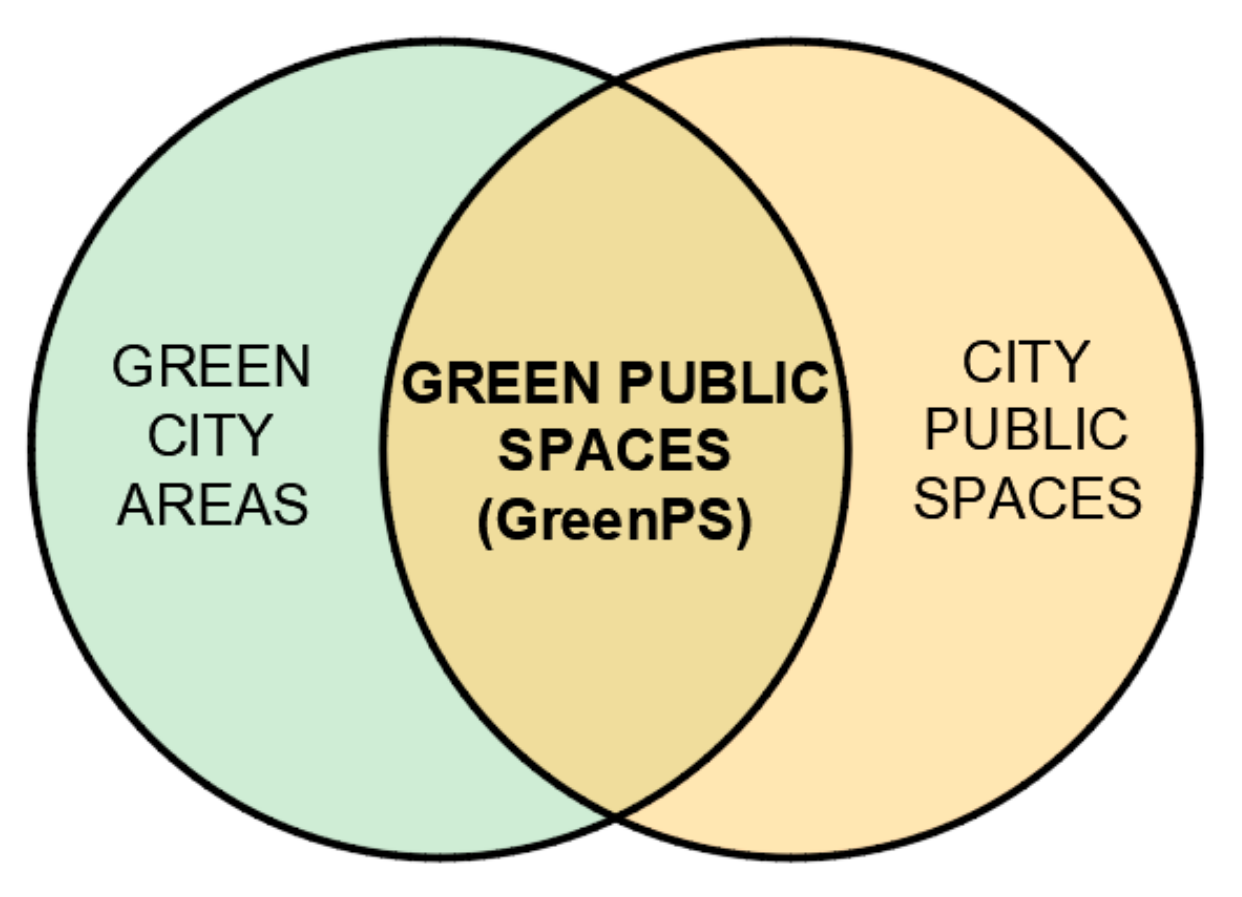
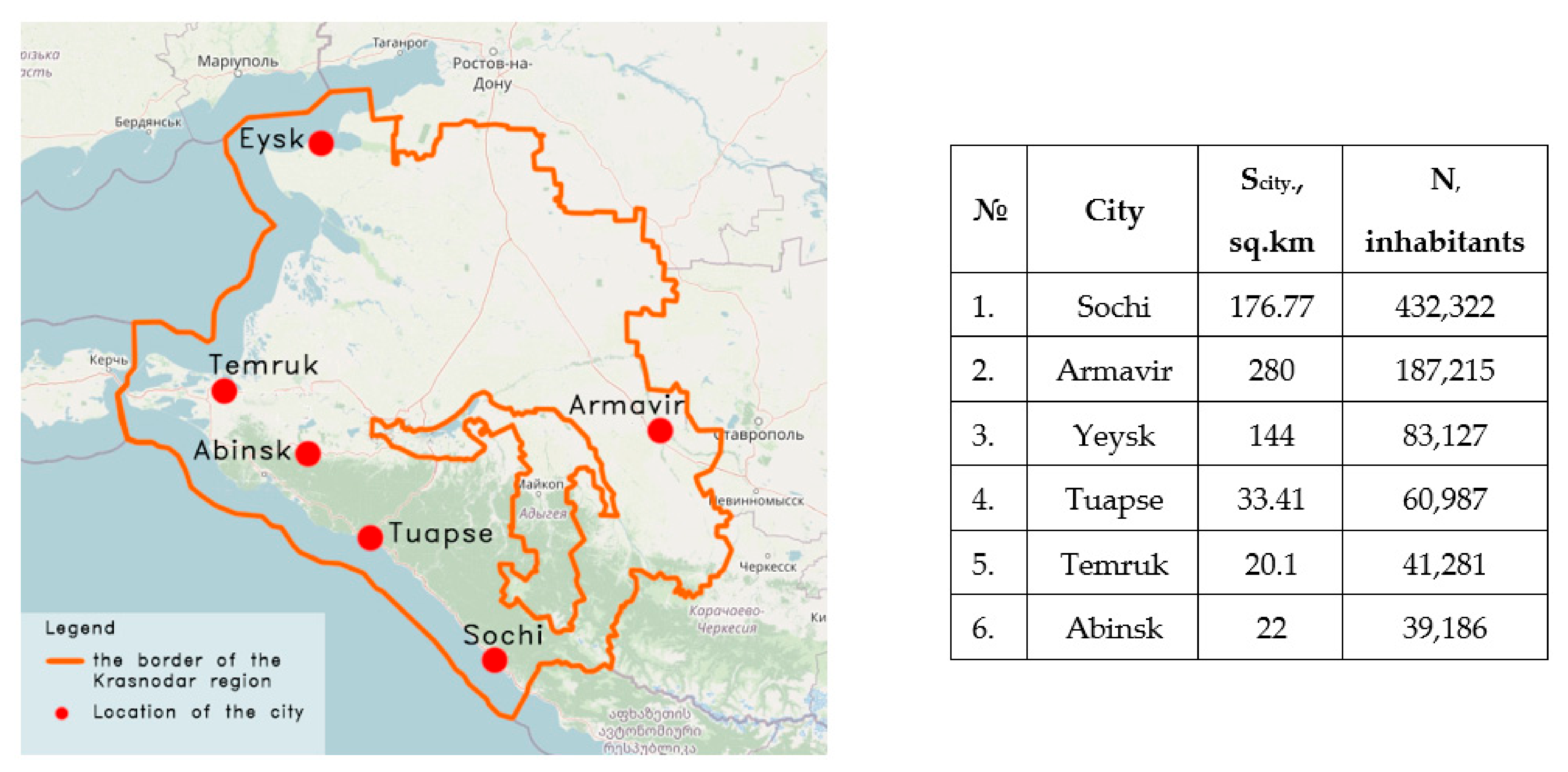
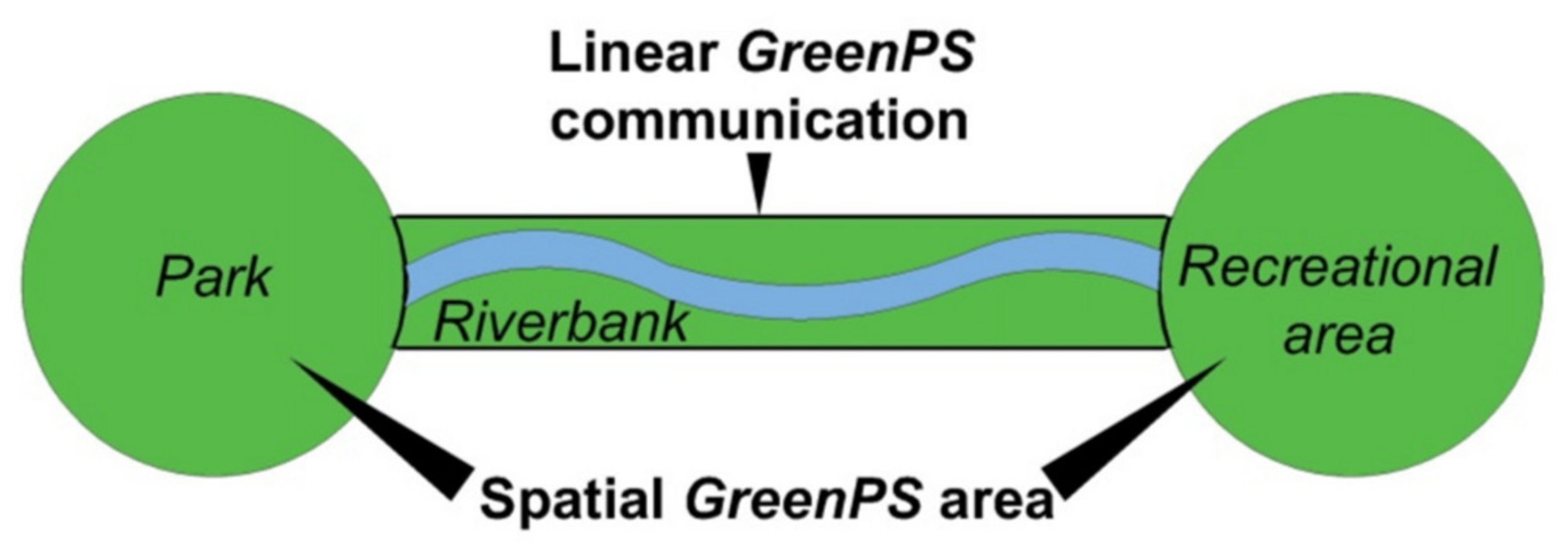
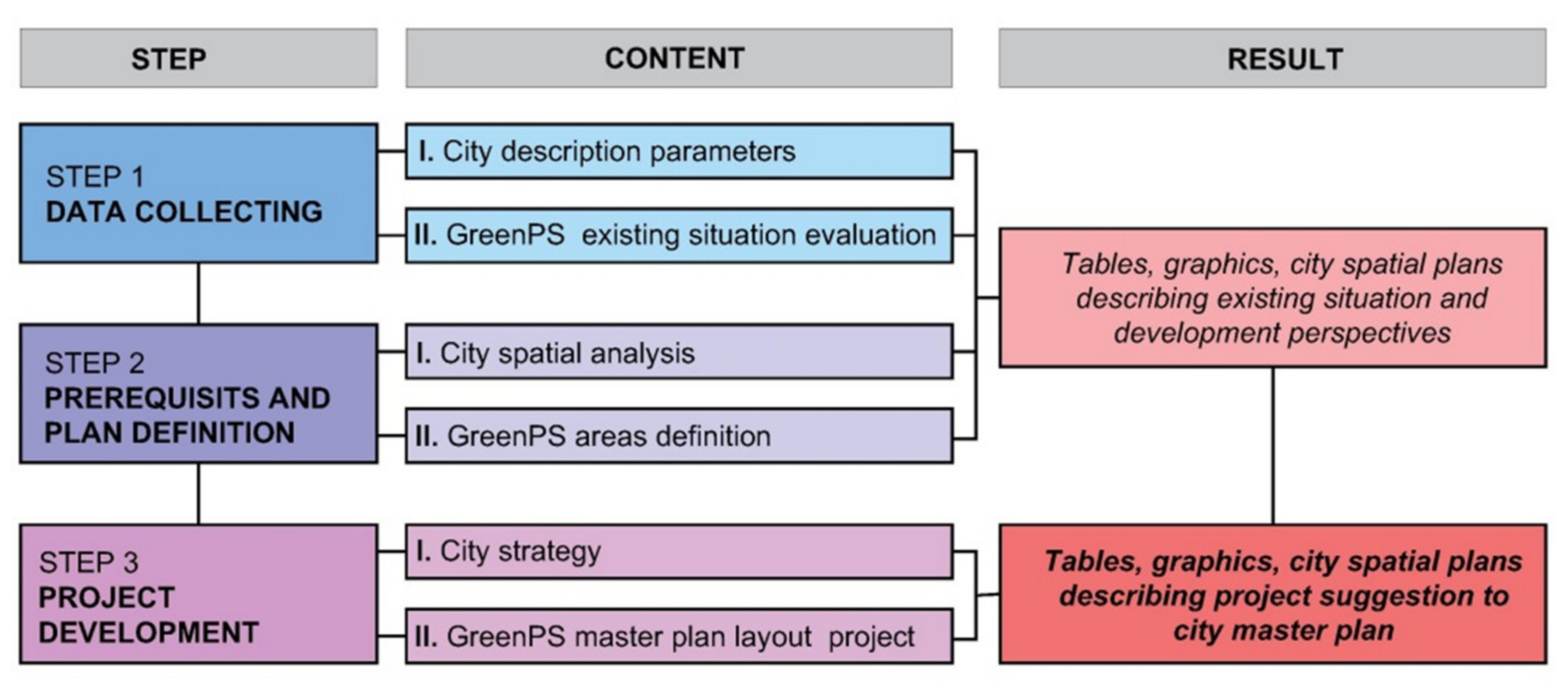
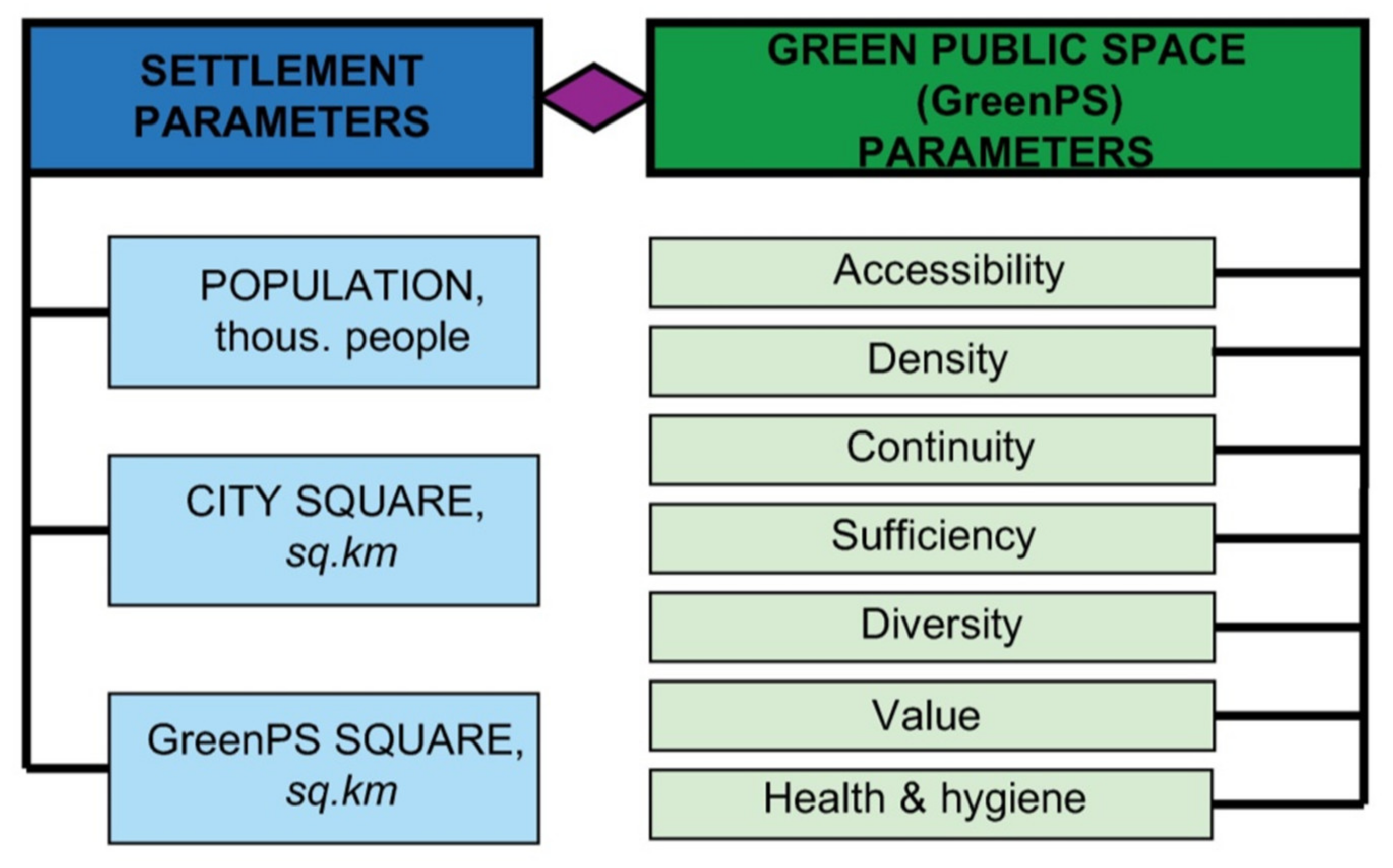
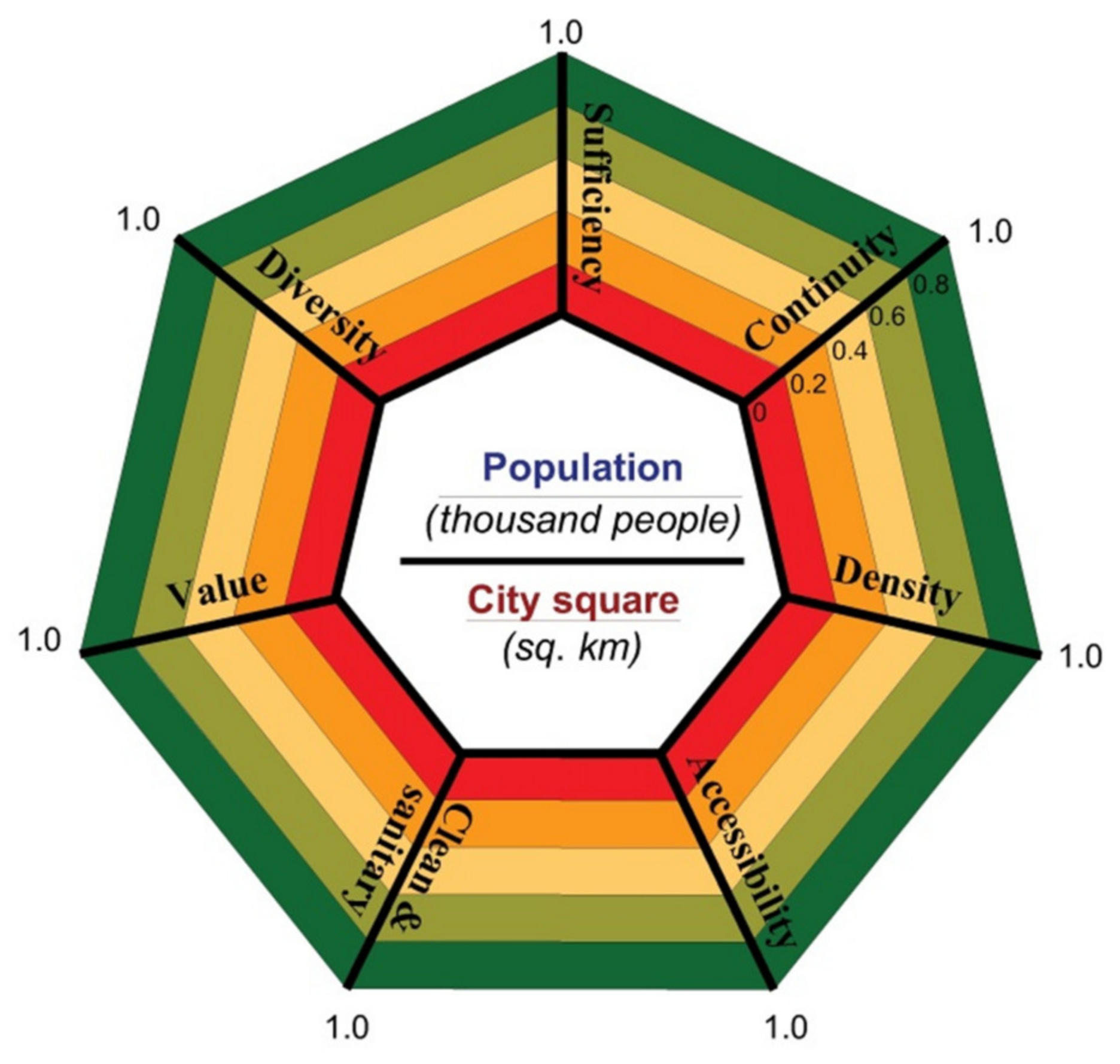
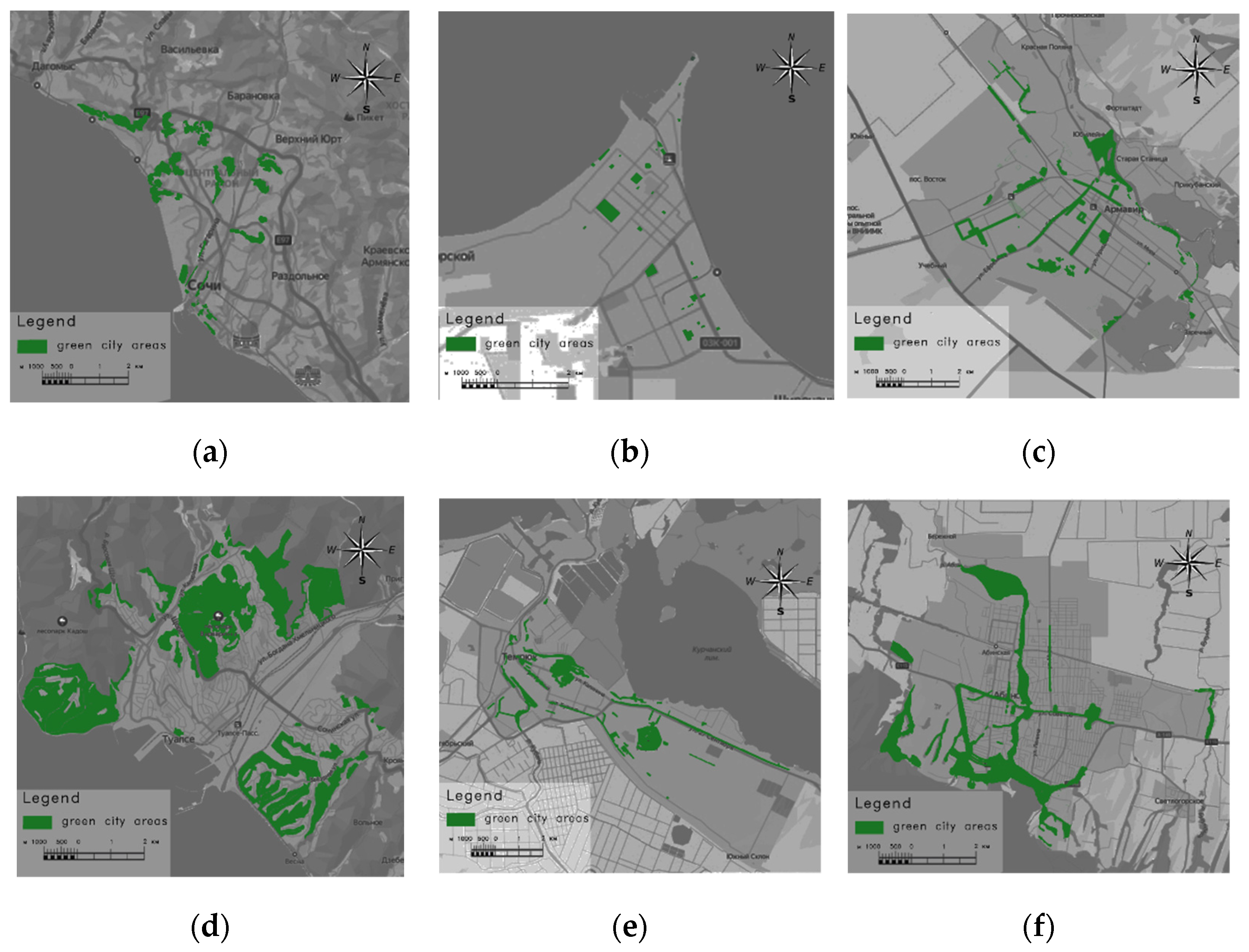
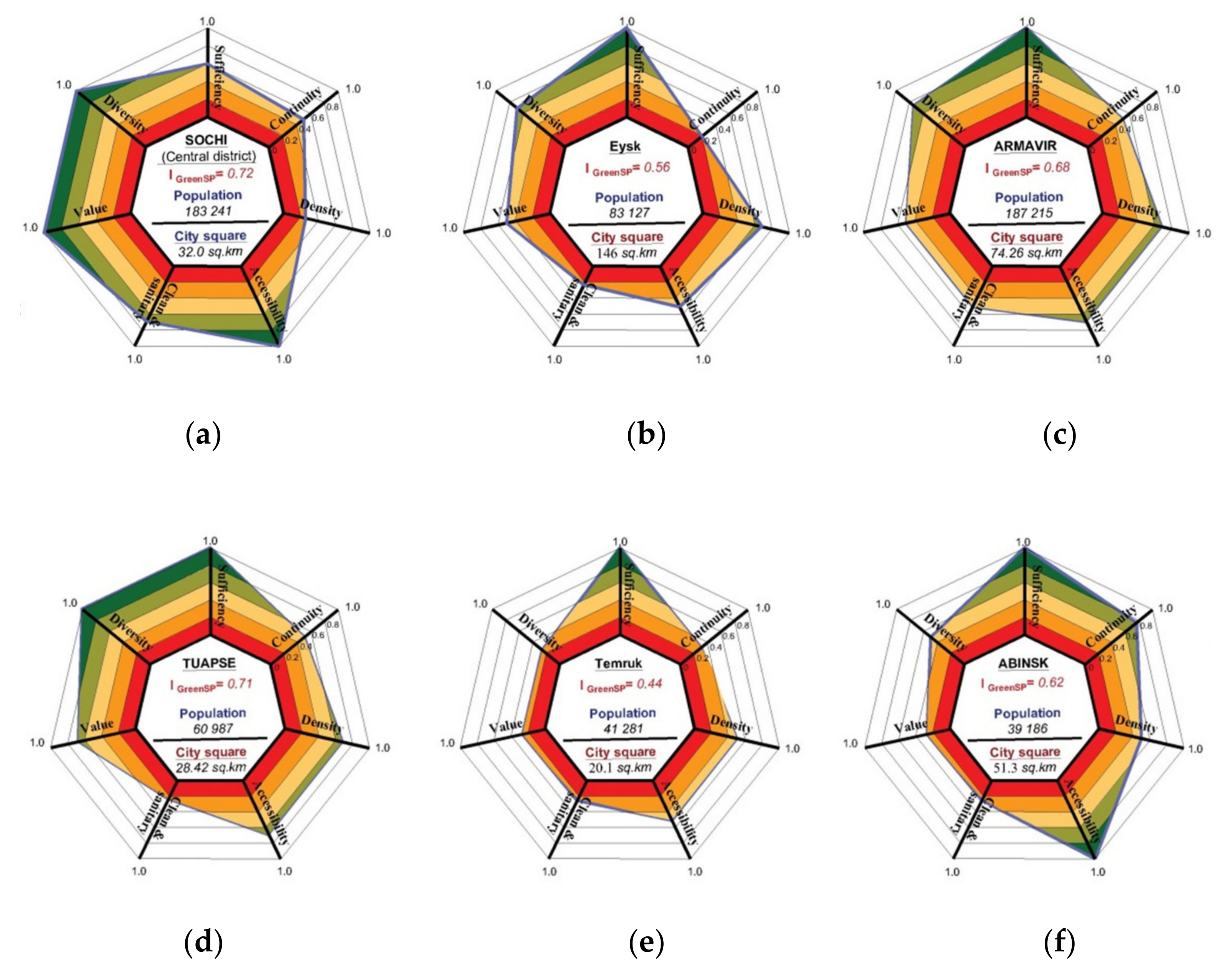
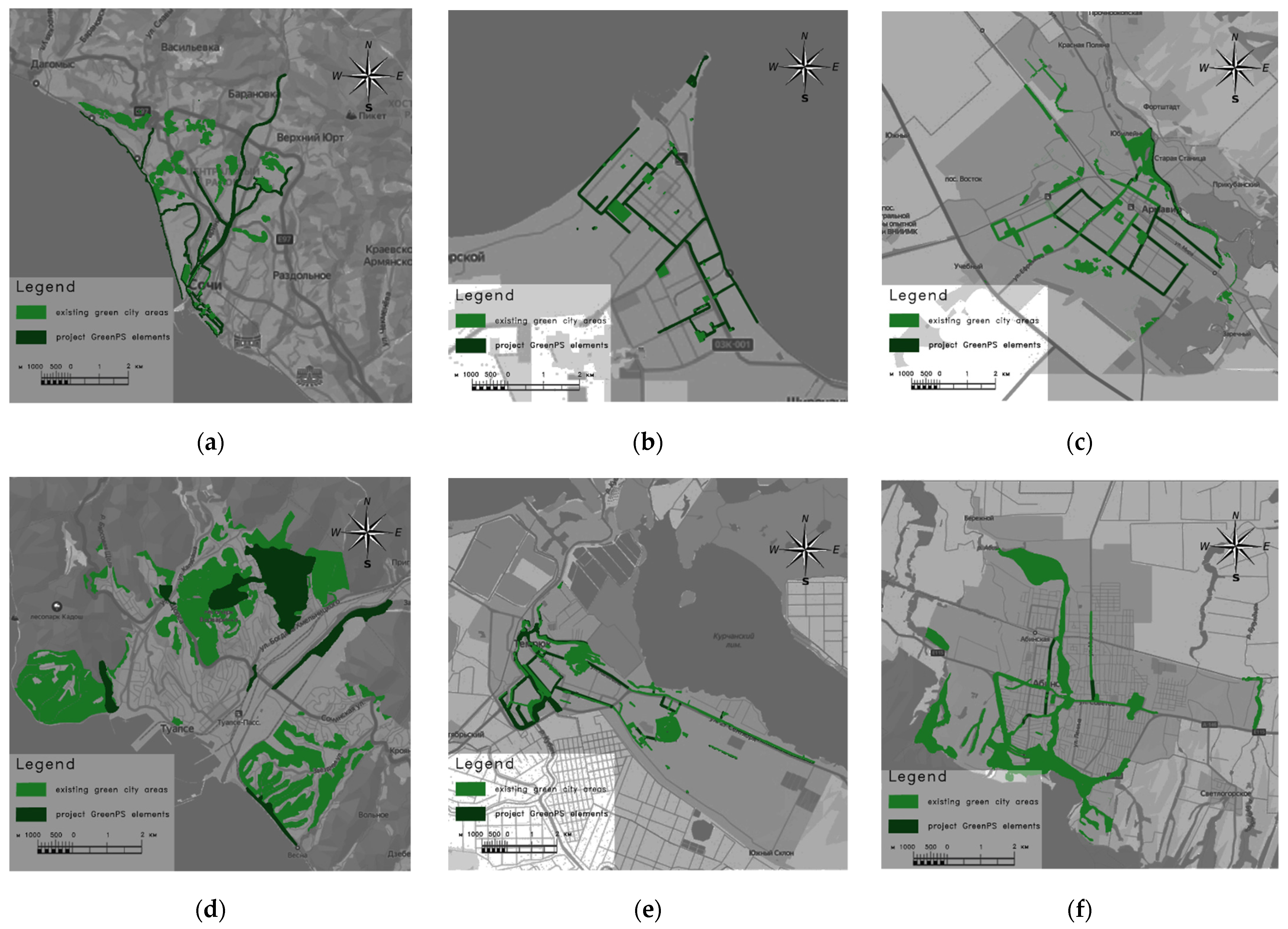
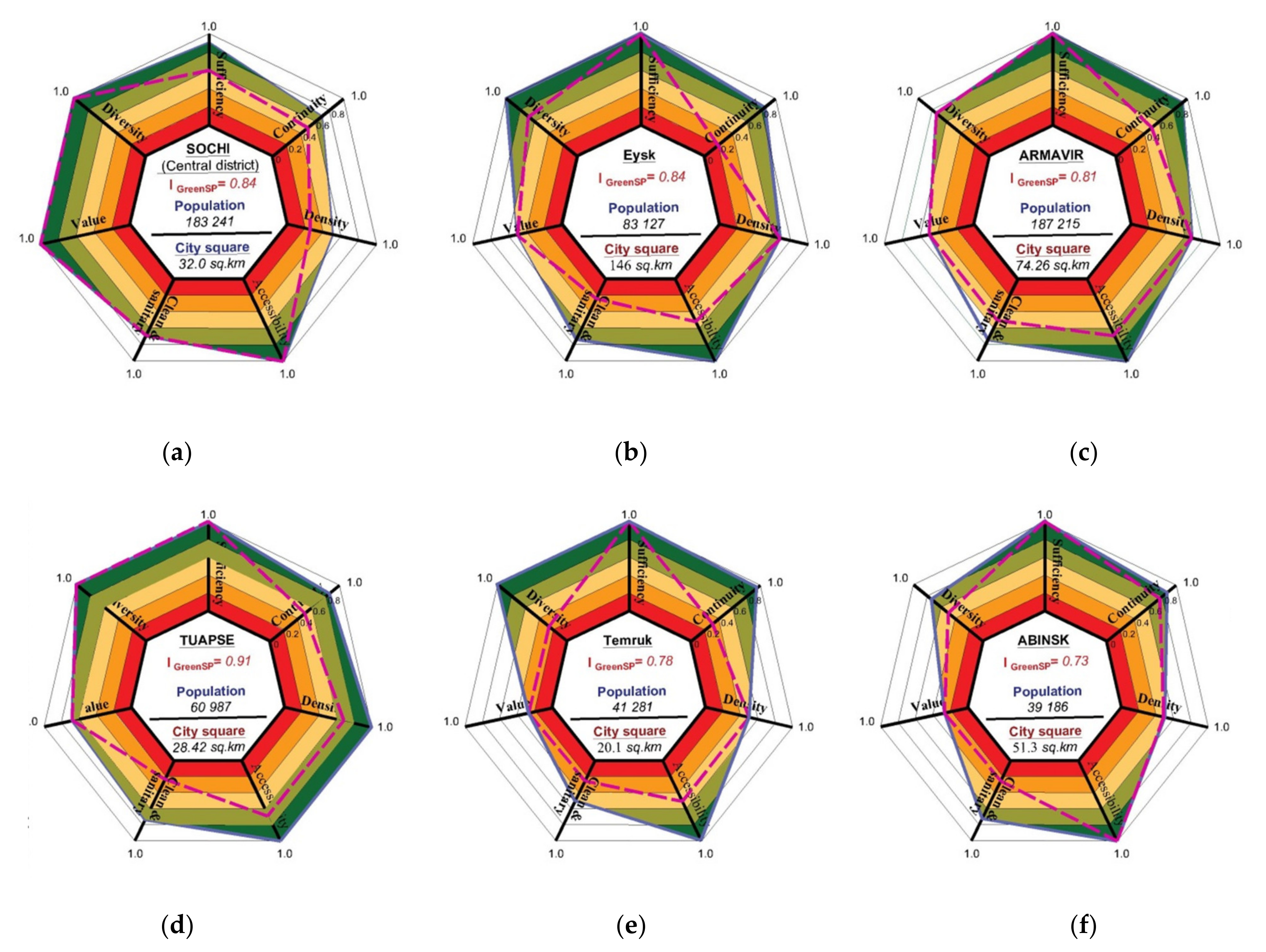
| Spatial Objects | Linear Corridors | ||
|---|---|---|---|
| Small urban green spaces, such as city gardens, squares, small parks and public playgrounds | 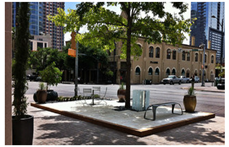 | Greened streets and rail tracks | 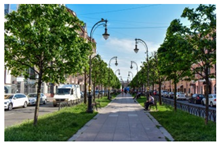 |
| District, city and regional parks and urban meadows | 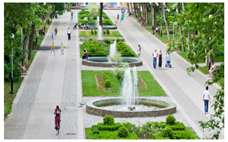 | Green pathways | 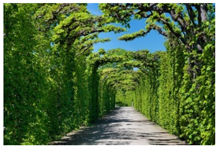 |
| Recreational and urban green facilities | 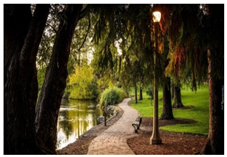 | Coastal, riverside, lakeside, seaside paths, linking green and blue spaces | 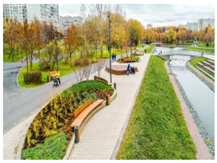 |
| Sustainability Pillars | GreenPS Network Impact | Examples |
| Society |
| 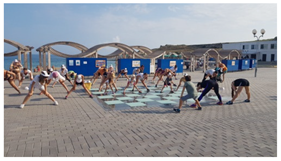 Source: http://project695285.tilda.ws/page3076798.html (accessed on 12 June 2021). |
| Economy |
| 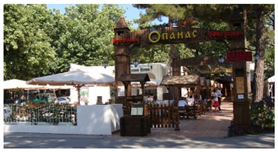 Source: https://www.na-more.su/gelen/2010/progulka.html (accessed on 12 June 2021). |
| Environment |
| 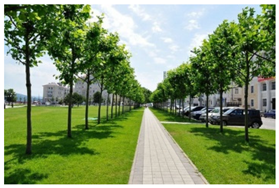 Source: https://ki-news.ru/2020/03/23/i-pust-alleya-zeleneet/amp/ (accessed on 12 June 2021). |
| Index | In | Description | Index Assessment |
| Accessibility | IA | Ratio of maximum time cost to its regular value (15 min) | , where TA—maximum time cost of pedestrian access to GreenPS (isochrones data), min; Treq.l—standard time cost of pedestrian access to GreenPS (15 min). |
| Density | IDN | Density coefficient | 0—less than 0.01 0.25—less than 0.1 0.5—from 0.1 to 0.25 0.75—from 0.25 to 0.5 1.0—not more than 0.5 |
| Sufficiency | IS | Ratio of existing sufficiency to its norms value | , where —present sufficiency of GreenPS, sq m/inhab.; Snorm—standard GreenPS sufficiency, sq m/inhab. |
| Continuity | IC | Ratio of the existing continuity to 100% | г∂e CGreenPS—existing continuity of GreenPS, %; Cmax—maximum project continuity—100%. |
| Diversity | IDV | Diversity coefficient | 0%—non-functional; 25%—mono-functional; 50%—neighborhood-scale functions integrated; 75%—city-scale functions integrated (cultural, historical and other character, tourist); 100%—regional-scale functions integrated (attracting regional economic investment). |
| Value | IV | Flora and fauna value coefficient | 0%—flora and fauna no attention paid; 25%—local flora and fauna; 50%—endemic flora and fauna present; 75%—protected zones which rich biodiversity; 100%—unique flora and fauna reserves. |
| Clean & Sanitary | IHH | Clean and sanitary supply coefficient | 0%—no infrastructure and equipment; 25%—inadequate infrastructure and equipment; 50%—satisfactory infrastructure and equipment; 75%—energy-efficient technologies partially integrated; 100%—infrastructure and equipment are energy efficient and technologically advanced. |
| City | Accessibility | Density | Sufficiency | Continuity | Diversity | Value | Clean and Sanitary |
| Regulatory/advised standard | 15 min | 0.5 | 9–15 (for touristic cities) | 100 | 100 | 100 | 100 |
| Measure unit | min | - | sq km/people | % | % | % | % |
| Sochi | 15 | 0.1 | 9.0 | 65 | 100 | 100 | 75 |
| Tuapse | 20 | 0.19 | 50.0 | 45 | 100 | 75 | 25 |
| Yeysk | 30 | 0.12 | 20.1 | 18 | 25 | 25 | 25 |
| Temruk | 30 | 0.12 | 43.75 | 33 | 75 | 50 | 25 |
| Armavir | 20 | 0.21 | 15.8 | 52 | 75 | 50 | 50 |
| Abinsk | 15 | 0.12 | 62.6 | 75 | 50 | 25 | 25 |
| Index | Accessibility | Density | Sufficiency | Continuity | Diversity | Value | Clean and Sanitary | Total | |
|---|---|---|---|---|---|---|---|---|---|
| IA | IDN | IS | IC | IDV | IV | IHH | |||
| City | Sochi | 1 | 0.25 | 0.6 | 0.47 | 1.0 | 1.0 | 0.75 | 0.72 |
| Tuapse | 0.75 | 0.75 | 1.0 | 0.45 | 1.0 | 0.75 | 0.25 | 0.71 | |
| Eysk | 0.5 | 0.75 | 1.0 | 0.18 | 0.75 | 0.5 | 0.25 | 0.56 | |
| Temruk | 0.5 | 0.5 | 1.0 | 0.33 | 0.25 | 0.25 | 0.25 | 0.44 | |
| Armavir | 0.75 | 0.75 | 1.0 | 0.52 | 0.75 | 0.5 | 0.5 | 0.68 | |
| Abinsk | 1 | 0.5 | 1.0 | 0.87 | 0.5 | 0.25 | 0.25 | 0.62 | |
| Index | Accessibility | Density | Sufficiency | Continuity | Diversity | Value | Clean & Sanitary | Total | Change in Comparison with Existing Values. % | |
|---|---|---|---|---|---|---|---|---|---|---|
| CITY | Sochi | 1 | 0.5 | 0.9 | 70 | 1.0 | 1.0 | 0.75 | 0.84 | +11.1 |
| Tuapse | 1 | 1.0 | 1.0 | 85 | 1.0 | 0.75 | 0.75 | 0.91 | +20.0 | |
| Eysk | 1 | 0.75 | 1.0 | 85 | 1.0 | 0.5 | 0.75 | 0.84 | +27.4 | |
| Temruk | 1 | 0.5 | 1.0 | 98 | 1.0 | 0.25 | 0.75 | 0.78 | +34.3 | |
| Armavir | 1 | 0.75 | 1.0 | 93 | 0.75 | 0.5 | 0.75 | 0.81 | +13.0 | |
| Abinsk | 1 | 0.5 | 1.0 | 87 | 0.75 | 0.25 | 0.75 | 0.73 | +10.7 | |
Publisher’s Note: MDPI stays neutral with regard to jurisdictional claims in published maps and institutional affiliations. |
© 2021 by the authors. Licensee MDPI, Basel, Switzerland. This article is an open access article distributed under the terms and conditions of the Creative Commons Attribution (CC BY) license (https://creativecommons.org/licenses/by/4.0/).
Share and Cite
Danilina, N.; Tsurenkova, K.; Berkovich, V. Evaluating Urban Green Public Spaces: The Case Study of Krasnodar Region Cities, Russia. Sustainability 2021, 13, 14059. https://doi.org/10.3390/su132414059
Danilina N, Tsurenkova K, Berkovich V. Evaluating Urban Green Public Spaces: The Case Study of Krasnodar Region Cities, Russia. Sustainability. 2021; 13(24):14059. https://doi.org/10.3390/su132414059
Chicago/Turabian StyleDanilina, Nina, Ksenia Tsurenkova, and Vladislav Berkovich. 2021. "Evaluating Urban Green Public Spaces: The Case Study of Krasnodar Region Cities, Russia" Sustainability 13, no. 24: 14059. https://doi.org/10.3390/su132414059
APA StyleDanilina, N., Tsurenkova, K., & Berkovich, V. (2021). Evaluating Urban Green Public Spaces: The Case Study of Krasnodar Region Cities, Russia. Sustainability, 13(24), 14059. https://doi.org/10.3390/su132414059







